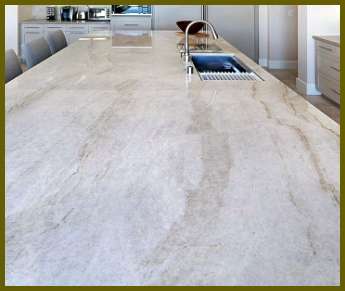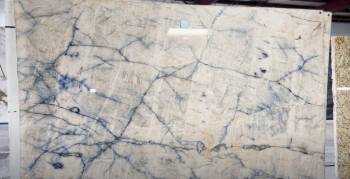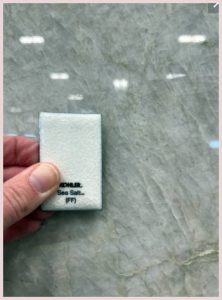Homeowners and designers alike are always searching for the perfect materials to create stunning and functional living spaces. In the world of countertops, two standout options are Cristallo and Taj Mahal quartzite. But how do you choose between these two luxurious stones?
Let’s dive into the pros and cons of each and help you make an informed decision for your next project.
A Brief Comparison Table
| Feature | Cristallo Quartzite | Taj Mahal Quartzite |
| Origin | Brazil | Brazil |
| Appearance | Translucent, crystal-like | Soft white, subtle veining |
| Durability | High | High |
| Maintenance | Low (mild soap and water) | Low (mild soap and water) |
| Price | High (premium) | High (but more affordable) |
| Availability | Limited | More accessible |
| Sealing Required | Depends on the specific slab | Yes, periodically |
| Style Suitability | Luxurious, unique spaces | Classic, versatile design styles |
| Alternatives | N/A | Calacatta quartzite, Super White granite |
A Tale of Two Quartzites: The Origins of Cristallo And Taj Mahal
Quartzite is a natural stone formed from sandstone that has undergone intense heat and pressure deep within the earth. This metamorphic process results in a dense and durable material that is highly sought after for its unique appearance and strength.
Cristallo and Taj Mahal are two popular varieties of this versatile stone.
Cristallo Quartzite
Hailing from Brazil, Cristallo quartzite is known for its translucent, crystal-like appearance. The stone features a light background with delicate veining in shades of gray and gold, giving it an ethereal, elegant look.
Cristallo is a popular choice for those seeking a luxurious and unique touch to their space.
Taj Mahal Quartzite

Also originating from Brazil, Taj Mahal quartzite boasts an understated elegance, featuring a soft white background with subtle gray and beige veining.
Its name is inspired by the famous Taj Mahal monument in India, known for its pristine white marble.
This stone is a favorite among homeowners and designers for its timeless beauty and neutral color palette.
Now that we’ve introduced these two stunning materials, let’s explore their strengths and weaknesses to help you make the best choice for your home.
Pros of Cristallo Quartzite
- Unique Aesthetic: Cristallo’s translucent nature and delicate veining make it a truly one-of-a-kind stone. This quartzite will add a touch of sophistication to any space.
- Durability: Like all quartzites, Cristallo is a durable and long-lasting material, resistant to scratches and heat.
- Low Maintenance: Cristallo quartzite is easy to clean, requiring only mild soap and water for routine maintenance.

Cons of Cristallo Quartzite
- Price: Cristallo quartzite is a high-end material, and its price tag reflects that. Expect to pay a premium for this luxurious stone.
- Limited Availability: Due to its unique nature, Cristallo can be more challenging to source than other types of quartzite, which could lead to longer lead times and increased costs.
Pros of Taj Mahal Quartzite
- Classic Beauty: Taj Mahal’s soft white background and subtle veining make it a versatile choice that can complement a variety of design styles.
- Durability: Like Cristallo, Taj Mahal quartzite is a durable and long-lasting material, resistant to scratches and heat.
- Low Maintenance: Taj Mahal quartzite is also easy to clean and maintain, making it a practical choice for busy households.
Cons of Taj Mahal Quartzite
- Price: While not as expensive as Cristallo, Taj Mahal quartzite is still considered a high-end material and can be pricey.
- Sealing Required: To maintain its pristine appearance, Taj Mahal quartzite should be sealed periodically to protect against staining.
Also Read: Reasons Why Calacatta Valentin Quartz Is Popular.
Frequently Asked Questions (FAQ)
Yes, Cristallo quartzite is a durable and long-lasting material. Like all quartzites, it is resistant to scratches, heat, and everyday wear and tear.
If you’re looking for a material with a similar appearance to Taj Mahal quartzite, consider options such as Calacatta quartzite or Super White granite. Both of these stones have a soft white background with subtle veining, making them excellent alternatives.
Cristallo quartzite is considered a high-end material, and its price reflects that. While costs can vary depending on factors like location and supplier, expect to pay a premium for this luxurious stone. Prices can range from $100 to $200 per square foot or more, depending on the grade and quality of the slab.
Despite its delicate appearance, Cristallo quartzite is not fragile. It is a durable and long-lasting material that can withstand the demands of everyday use. However, it is essential to treat all natural stone countertops with care, as improper use or installation can lead to damage.
Taj Mahal quartzite is an excellent choice for those seeking a durable, low-maintenance, and beautiful countertop material. It’s classic appearance and neutral color palette make it a versatile option that can complement various design styles. Keep in mind that it is still considered a high-end material, so be prepared for a higher price tag compared to more common options like granite or quartz.
In Conclusion
Both Cristallo and Taj Mahal quartzite are stunning and durable materials that can elevate the aesthetic of your space. Ultimately, the choice between these two luxurious stones will come down to personal preference and budget.
If you’re seeking a truly unique and luxurious touch, Cristallo quartzite’s translucent, crystal-like appearance might be the perfect fit. However, be prepared to pay a premium for this one-of-a-kind stone and potentially face limited availability.
On the other hand, if you prefer a classic and timeless look, Taj Mahal quartzite’s soft white background and subtle veining make it a versatile choice for various design styles. While still a high-end material, Taj Mahal quartzite is generally more affordable and accessible compared to Cristallo.
No matter which material you choose, both Cristallo and Taj Mahal quartzite are sure to provide a stunning and durable surface that will stand the test of time.




Súper good this article!!!